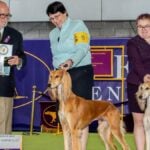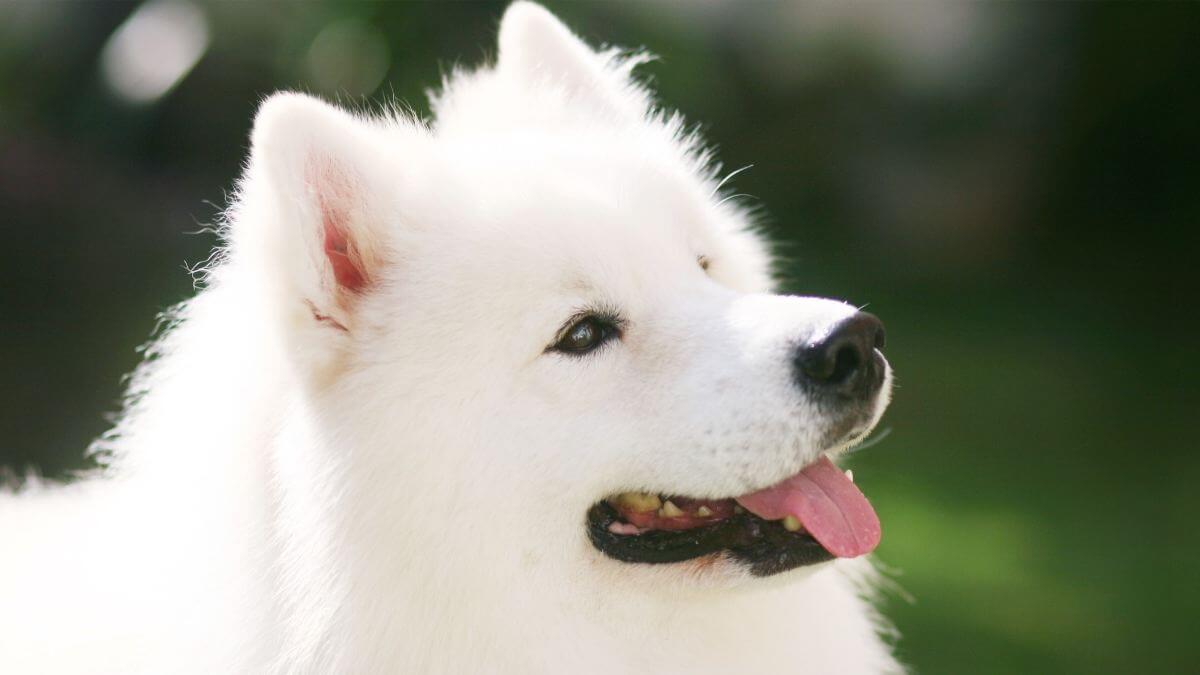
Home » Judging the Samoyed

This article was originally published in Showsight Magazine, August 2015 issue.
About 25 years ago, while watching a judge make a total hash of judging our Samoyeds, I thought, “Good grief, even I can do a better job than that.” That judge put up a very pretty, but cow-hocked dog, obviously forgetting that this is a working breed. There were other, more acceptable choices in her ring. Do you think she ever got another entry from me or the knowledgeable observers ringside?
Judges should realize that the spectators, especially those sitting in the “breeder’s corner,” are judging the dogs right along with them. To a newbie, that breeder’s corner can be rather intimidating, and so it should be. Make friends of those serious breeders and seek their knowledge of the breed. There is a lot to learn from some of those experienced fanciers. You can find a mentor there.
Most judges judge for the love of dogs. Breeder judges are fully aware of the assets and faults of their breed. We need to try to be even-handed and balance the faults and virtues. Sometimes we have to forgive a minor fault in order to reward a very important virtue.
Remember that this is the “Handyman of the North.” He has to be able to handle anything asked of him. A Samoyed is the triple threat of the Arctic, a dog who does Herding, Hunting, and Hauling, plus whatever else his people needed him to do, such as sleeping in the tents with the people to keep them warm and to guard them. No way can the Samoyed be called a specialist.
To help you remember, the Alaskan Malamute is the large, dependable freight hauler. The Siberian Husky is the speedy runner, and the Samoyed is the dog in the middle who does it all. Could the fact that he spent time in the reindeer hide tents with the Samoyed people be responsible for the current wonderful temperament we enjoy?
The breed originated basically from twelve dogs imported from the Arctic. They were not all the same, having come from different areas around the Arctic Circle, mainly in Siberia. Therefore, we have a plethora of acceptable types or styles within the breed. Some of the original dogs were brown or black; however, it has been said that the whitest ones came from the farthest North.
As to temperament in this smiling breed, it is helpful to remember that they originated with a subsistence-level people. If the dog couldn’t contribute or get along with the other camp dogs, he ended up in the soup pot. That’s not a pretty picture, but I have to think it was an efficient way to cull out the dogs with traits we don’t want perpetuated. We are the benefactors of that practice.
Samoyeds have a real drive to please their people. Just look at a weight pull where the dogs are pulling their hearts out. They have no reason to do this other than they know it will please us. Look at the joy of dogs doing Agility with their people. The most successful dogs have a driving need to work with their humans. While you cannot completely judge temperament in the show ring, you can sure see the dogs who want to please their people.
Keeping in mind the environment around the Arctic Circle and purpose of the breed, we can address the type issues. Medium-sized, well-furred, rounded tip ears stand up to Arctic blasts better than bigger, pointy ears, which are not well-furred and are more susceptible to freezing. Well-set almond eyes are better in a blizzard than a round or protruding eye. Eyes should be dark for preference, but a dog can see perfectly well with slightly lighter eyes. That is a cosmetic thing. The standard doesn’t say dark brown, so would dark green be acceptable? I think not. We need to tighten the standard up a bit there, as well as include cream with biscuit in the color section.
Speaking of color, there was a truly scrumptious bitch shown in the upper Midwest who had a golden biscuit body with a stark white tail and neck. She looked like a palomino. She could have found kennel space at my place any time.
Feet that are hare-footed and slightly spread get better grip in the snow. A thick, double coat allows them to sleep in the snow and be perfectly comfortable. A proper tail is essential, as when curled up with the tail over the nose, it filters the cold air, making a good tail important. That same tail will be used as a rudder when making quick turns to head off an escapee from the herd.
Do yourself, and the breed, a favor and just judge the dogs. Judges who look at the wrong end of the lead are destroying the whole sport of dog shows. We cry that we don’t have enough new people coming into the sport. If you went to a dog show and saw blatant favoritism toward some handlers or exhibitors, what would be your reaction? Too often, it is: oh no, I am not playing this game where the cards are stacked against me. Just judge the dogs. It is up to you to find the best dog, even if it is not handled to perfection. You are not looking for the best-handled dog, you are looking for the best dog. Yes, you need to see the dog properly, but sometimes a little extra time soothing a nervous exhibitor and the dog is well spent.
Okay, let’s start at the beginning. Bring the dogs in, check them off in your judge’s book, and have them stack up so you can take an overall view of your entry. You are looking for a dog that is just off square, about half a bubble off. You might see one that has the proportions of a giraffe, one that looks as though it lacks the substance called for in the standard. One has a gorgeous neck, which makes you want to check if that shoulder is really as laid back as that neck would indicate, or is it just a good sculpting job. A good number of them look well-balanced. It is a nice entry, so this is going to be a pleasure to do, as any judging assignment should be.
Send them around to check for any that are limping. Might as well get over that hurdle right at the beginning. The first thing you will encounter in the individual examination is the head.
The standard quite specifically says Samoyed expression is very important. It calls for a lighting up of the face and the famous Samoyed Smile, which is made up of proper eyes, ears, and lip line. There should be a well-defined stop. Sometimes when you see that smiling face, you just want to smile right back. The Samoyed smile can even be seen while he is sleeping.
This is a very natural breed. Of course, we want a clean coat with its silvery sheen, which is called for in the Breed Standard. When shown outside, you will see actual silver tips on the coat. This is more difficult to discern under artificial lights. The male carries more of a ruff than the female. The thick double coat is a survival issue. However, a dog in full bloom in August is simply dumb. Males will throw out the undercoat in the summer, but bitches are hormone-driven and will do a coat dump about four months after their season, whether she had a litter or not. This would be when her pups would be eight weeks old.
In spite of his huggable appearance, this is a working dog, not a lay-around-on-the-couch-and-be-a-decoration dog. Therefore, he needs to be balanced. We want a good shoulder layback and a balancing bend of stifle. We want that strong, straight topline. You will have to get into that coat and feel if the topline is really as it looks or if it’s a good grooming job. Your hands will tell you what is under there, or if there has been creative grooming or scissoring. When checking the rear configuration, again, you need to feel. Some groomers create stifle puffs to fool the judge’s eye. The handlers and groomers’ job can be to fool the judge. Your hands will tell the truth. And the ultimate truth will be revealed when the dog moves.
A good Samoyed has a confident, well-timed working trot that is very efficient. Coming, going, and side gait are equally important. If he has a wonderful side gait but bobbles coming at you or going away, efficiency is destroyed. The rear does not overreach the front at a working trot. For efficiency, this breed single-tracks to get the support under the center of gravity. We want to see a V-shaped column of support from the feet to the shoulder or hip when moving quickly. The faster the dog is moving, the more the feet will converge under the centerline of the dog. The well-put-together Samoyed shows strong rear drive and good reach in the front. There must be follow-through in the rear; however, extended time off the ground is inefficient.
Any dog that falls within the 21″-23½” range for males or 18″-21″ for bitches is correct. Penalize only for the extent of the deviation. Interestingly, the top size for a Siberian Husky male is exactly the same as for the Samoyed male. The perceived difference is that a Samoyed can carry a 4″-6″ ruff at the withers. Get your hands in there and see where the withers really are.
The same thing goes for elbows. You must feel to know where that elbow actually is, as the hair hanging down on the underbody can deceive you.
The perfect dog hasn’t been born yet; however, I have seen a few that come mighty close. Every once in a while, amidst the usual run of the mill, an animal appears with this splendid thing called true quality. It is so fine, strong, and clear that it is like a sudden bright light. It is a combination of true type and soundness. Once seen in a living thing, it is not easily forgotten. But no dog is perfect. In balancing faults and virtues, you may have to forgive a minor fault in order to reward a great virtue.
Judging this breed is pure pleasure. The Samoyed is the dog that will smile at you… and mean it.